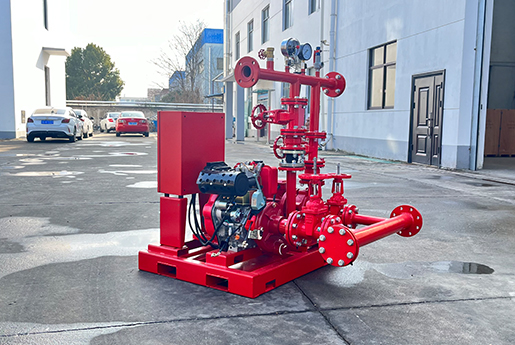What are the safety considerations when using firefighting pumps?
Feb 06, 2024
Share:
Using firefighting pumps requires careful attention to safety to ensure the effectiveness of firefighting efforts and the well-being of personnel. Here are some key safety considerations when using firefighting pumps:
1. **Training and Certification:**
- Ensure that personnel operating firefighting pumps are properly trained and certified in pump operation and firefighting procedures.
- Regularly conduct training sessions to keep personnel updated on the latest techniques and safety protocols.
2. **Read and Understand Manuals:**
- Familiarize yourself with the manufacturer's instructions and operation manuals for the specific firefighting pump you are using.
- Follow the recommended maintenance schedules and procedures outlined in the manuals.
3. **Personal Protective Equipment (PPE):**
- Wear appropriate personal protective equipment, including firefighting gear, gloves, helmet, eye protection, and hearing protection if necessary.
4. **Site Assessment:**
- Conduct a thorough site assessment before deploying the firefighting pump to identify potential hazards and plan for safe pump placement.
5. **Proper Pump Placement:**
- Ensure the firefighting pump is placed on stable ground to prevent tipping or movement during operation.
- Avoid placing the pump near exhaust fumes, fuel sources, or other potential ignition points.
6. **Fuel Safety:**
- Use the correct type and amount of fuel specified by the manufacturer.
- Store fuel in approved containers away from heat sources and open flames.
7. **Electrical Safety:**
- Follow electrical safety guidelines when using electric pumps, including proper grounding and protection against electrical shocks.
- Keep electrical components and connections dry and away from water sources.
8. **Regular Maintenance:**
- Conduct regular maintenance checks on the firefighting pump, including inspecting hoses, nozzles, and connections for any signs of wear or damage.
- Ensure that the pump is in good working condition before each use.
9. **Fire Hydrant Connections:**
- When connecting to a fire hydrant, follow proper procedures to prevent water hammer effects and ensure a secure connection.
10. **Safe Water Sources:**
- Ensure the water source is safe and free from contaminants that could damage the pump or compromise firefighting efforts.
11. **Communication:**
- Establish clear communication channels among the firefighting team to coordinate pump operations effectively.
- Have emergency communication devices available in case of unforeseen situations.
12. **Weather Conditions:**
- Consider weather conditions such as strong winds, extreme temperatures, or heavy rain that may affect pump operation and overall firefighting efforts.
13. **Emergency Shutdown Procedures:**
- Train personnel on emergency shutdown procedures and ensure they are familiar with how to quickly and safely stop the pump in case of any issues.
By prioritizing these safety considerations, firefighting personnel can enhance their ability to respond effectively to emergencies while minimizing risks to themselves and others involved in firefighting operations.

1. **Training and Certification:**
- Ensure that personnel operating firefighting pumps are properly trained and certified in pump operation and firefighting procedures.
- Regularly conduct training sessions to keep personnel updated on the latest techniques and safety protocols.
2. **Read and Understand Manuals:**
- Familiarize yourself with the manufacturer's instructions and operation manuals for the specific firefighting pump you are using.
- Follow the recommended maintenance schedules and procedures outlined in the manuals.
3. **Personal Protective Equipment (PPE):**
- Wear appropriate personal protective equipment, including firefighting gear, gloves, helmet, eye protection, and hearing protection if necessary.
4. **Site Assessment:**
- Conduct a thorough site assessment before deploying the firefighting pump to identify potential hazards and plan for safe pump placement.
5. **Proper Pump Placement:**
- Ensure the firefighting pump is placed on stable ground to prevent tipping or movement during operation.
- Avoid placing the pump near exhaust fumes, fuel sources, or other potential ignition points.
6. **Fuel Safety:**
- Use the correct type and amount of fuel specified by the manufacturer.
- Store fuel in approved containers away from heat sources and open flames.
7. **Electrical Safety:**
- Follow electrical safety guidelines when using electric pumps, including proper grounding and protection against electrical shocks.
- Keep electrical components and connections dry and away from water sources.
8. **Regular Maintenance:**
- Conduct regular maintenance checks on the firefighting pump, including inspecting hoses, nozzles, and connections for any signs of wear or damage.
- Ensure that the pump is in good working condition before each use.
9. **Fire Hydrant Connections:**
- When connecting to a fire hydrant, follow proper procedures to prevent water hammer effects and ensure a secure connection.
10. **Safe Water Sources:**
- Ensure the water source is safe and free from contaminants that could damage the pump or compromise firefighting efforts.
11. **Communication:**
- Establish clear communication channels among the firefighting team to coordinate pump operations effectively.
- Have emergency communication devices available in case of unforeseen situations.
12. **Weather Conditions:**
- Consider weather conditions such as strong winds, extreme temperatures, or heavy rain that may affect pump operation and overall firefighting efforts.
13. **Emergency Shutdown Procedures:**
- Train personnel on emergency shutdown procedures and ensure they are familiar with how to quickly and safely stop the pump in case of any issues.
By prioritizing these safety considerations, firefighting personnel can enhance their ability to respond effectively to emergencies while minimizing risks to themselves and others involved in firefighting operations.


.png)
.png)

.png)


